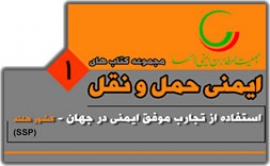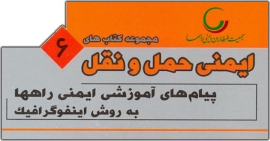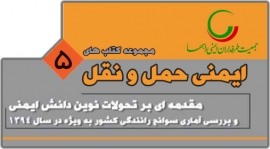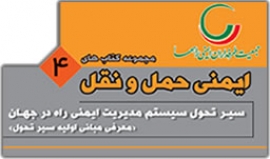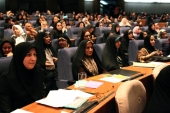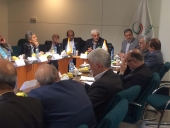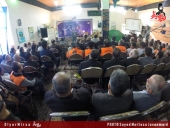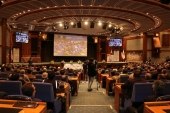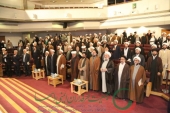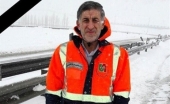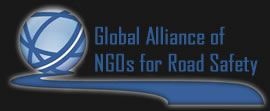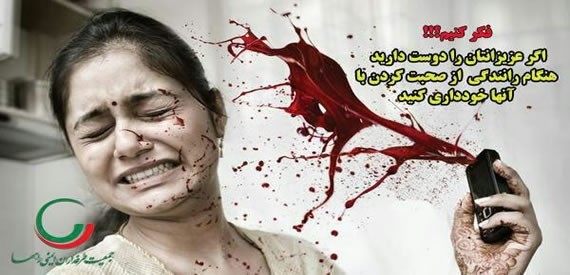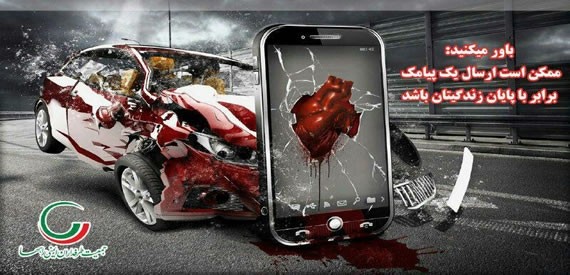
مدیر سایت
اطلاعیه
First Nationwide Women Safety Alliance Meeting for Promotion of Safety Culture
The first nationwide women safety alliance gathering for promotion of safety culture was held with the participation of more than 1,500 women active in social affairs and NGO groups, including members of the NGO network, women cultural social centers, cultural houses and the organizing staff of NGOs as well as a number of women injured in incidents.
The event was held on June 16, 2016 at the IRIB Convention Center in the presence and under the support of dignitaries, including Vice-President for Women and Family Affairs, head of the Road Maintenance and Transportation Organization, Women Affairs Advisor to the Ministry of Road and Urban Development and a number of other ministries, and also women specialists, veterans, artists, media members, etc.
At the beginning of the meeting, Mohammad Bokharaei, Chairman of the Board of Directors of the Road Safety Supporters Society (RSSS), while welcoming the audience said the objective behind holding the gathering was to participate women supporters of road safety in line with the slogan of promoting culture of road safety in the year of ‘economic culture and support for national determination’. He added that on the eve of this year’s New Year, a similar gathering with the presence and participation of 1000 public transportation drivers was held.
He described women as one of the most effective demographic spectrums who play an influential role in the development of safety culture and said with the support of this spectrum traffic crashes can be reduced to a great extent.
The Chairman of RSSS Board of Directors also referred to the calendar year 1392 (2013/2014) when 24% of the fatalities of urban traffic crashes were women and noted that the average age of the women killed in traffic crashes was 28 years, which shows that traffic crashes have claimed the lives of many would-be mothers.
He added: “The presence of women in the victory of the (1979) Islamic Revolution, the Sacred Defense (Iraqi war against Iran 1980-88) and development of construction has been very strong and for this reason women can be effective in reducing the damage caused by traffic crashes.”
Bokharaei put the number of deaths in 2013/2014 at 18,000 despite some reduction and said 310 thousand people were also wounded in traffic crashes. The survivors of the crashes who are mainly women are a group who suffer highly.
The Chairman of RSSS Board of Directors also pointed to the holding of the third gathering of advocates of road safety with the presence of the clergy and said such gatherings are planned to be held with the participation of university students and academics.
Meanwhile, Ms. Shahindokht Mullaverdi, Vice-President for Women and Family Affairs told the gathering that the frequency of traffic crashes in the country is an alarming issue. “The risk is endangering all and all of us are responsible towards this issue.” Stressing that development of a sense of social responsibility should be put on the government agenda as well as the entire system, she noted that there is this reality that every time the civil society has been weakened and the government in different political, social, economic and cultural areas has become oversized, inefficiencies have become more and as a result dissatisfaction has increased. “In order to pass through this weak civil society and reach a dynamic, happy and powerful society, a remedy should be sought.”
The Vice-President also expressed hope that in a year which demands national determination and jihadi management for economy and culture, positive and effective steps will be taken on the culture of road safety in which women can play a significant role and the necessary infrastructures will be provided for this purpose.
Another speaker of the gathering, Deputy Road and Urban Development Minister and Head of the Road Maintenance and Transportation Organization Engineer Davoud Keshavarzian while appreciating the organizers of the forum, said that each year thousands of people are killed and wounded in traffic crashes. “Although vehicle and road play their role in traffic crashes and can enhance human error, however the human factor is involved in these incidents as the most important factor. But, it should be realized that the degree of human error of the one driving in an equipped car is not the same as the driver of a vehicle with insufficient equipment.”
The head of the Road Maintenance and Transportation Organization stressing that good roads will reduce human casualties, noted that his organization is making effort to minimize the share of the road in traffic crashes as much as possible. Referring to the important role of human beings in traffic crashes, he pointed out that for the sake of culture building in this regard, all social organizations should play a part and expressed hope that such gatherings will be effective in reducing traffic crashes and in attracting the public attention and making people more sensitive.
It should be noted that in this gathering, three specialized sessions and two short films titled “Warning” and “Crash Survivors” and five educational short films in animation form were presented.
In the first session, members of the panel were Mesdames Dr. Jalali, Dr. Khalooq and Fariba Kowsari who discussed about safety indicators in Iran and the world.
The title of the second session was public demand in the field of road safety in which Mesdames Dr. Amiri, Dr. Shariati, Dr. Tabibi and Mohammadi Peykar discussed the topic with the participation of the audience.
The third and the last panel was held with the participation of Mesdames Engineer Moqimi, Dr. Shahsavand and Dr. Navabinejad during which the plan for effective participation of women in the promotion of safety culture was discussed with the participation of the audience.
In conclusion of the discussions, Ms. Engineer Sadeqi, the Secretary of the conference, presented the following sum-up of the topics discussed in the three panels:
• Measures to be followed up by executive agencies and public organizations for promotion of road safety
1. Strengthening the safety structure in the government body and designating a specified custodian to overcome the problems and reduce intercity and intracity fatalities (cross-organizational structure under the supervision of the President)
2. Allocating a percentage of the revenues of insurance companies for promotion of safety culture through implementation of educational and promotional programs by using public organizations and educational institutions
3. Developing control networks for the physical and mental health of drivers of public vehicles through the private sector and under the supervision of the government and making constant monitoring of the status of drivers of public vehicles mandatory
4. Using women police as regulatory safety patrols, especially in educational areas
5. Strengthening and boosting enforcements in the county and optimum use of the organized public forces as the Subtle Police in line with promotion of safety culture
6. Designing and developing a national symbol and installing it in all places where road traffic crashes have claimed the lives of one of our loved ones
7. Increasing the extent of road safety training in educational text books for different age groups
8. In the scouts programs “Safety Scouts” should have a place too
9. Organizing specific educational workshops at the level of neighborhoods and parks for the local people and description of the driving effects under the influence of barbiturates, alcohol, drowsiness, stress, anger and nervousness and ...
10. Identification and appreciation of those who have taken a positive step in promotion of safety culture in any field and any region
11. Repetition of driving violations should be turned into crime and also, mandatory training networks should be developed for the drivers and those who are not eligible should be banned from driving
12. Paying special attention to the training of motorcyclists and their safety tips with regard to the fact that (about 46% of the traffic fatalities relate to the motorcyclists, pedestrians and bicyclists) as well as mandatory training of motorcyclists instead of seizing their motorbikes
13. Developing driving training simulators for the children, promoting the sound way of driving from childhood and developing traffic educational spaces in parks and playgrounds for kids
14. Interaction with religious missionaries and the related networks, including the Friday Prayers Council for attaching importance to safety issues and respecting the law in religious beliefs
15. Correcting the society’s misconceptions with regard to women drivers
16. Transparency in the system of statistics and data about crashes and definition of different levels of access to this information
17. Serious measure in the field of standardization of vehicles
18. Developing specific campaigns for women alignment for the promotion of safety culture throughout the country (by using virtual space)
At the end of the first nationwide women gathering for promotion of safety culture a covenant letter was read out by the Secretary of the conference which received approval of all the participants.
RSSS Strategic Plan for 2016/2017
The strategic plan of the Road Safety Supporters Society (RSSS) in the calendar year 1395 (2016/2017) was announced at a gathering of the headquarters and provincial managers as follows:
Operational Strategy of Provincial Offices in 1395 (2016-2017)
The Road Safety Supporters Society (RSSS) started its activities in 1386 (2007-2008) by reliance on the Almighty God with an aim of improving the status of road traffic safety and promoting traffic culture as a national, non-governmental and non-political institute and by benefiting from the experience and knowledge of its members.
With firm belief in this motto, the RSSS members and supporters started observance of the safety principles and correcting risky behaviors in driving as a first step within themselves in the forefront with the ideal slogan of ‘even one dead is too many’,
The society strives to improve and correct behavior of the road users and change their high risk behaviors into safe behaviors based on the observance of driving rules and regulations through operational strategies prioritizing safety of motorcyclists. The society is persuing the following goals in provinces:
1- Efforts for maximum participation of people in the promotion of roads safety
• Using the potentials of social networks including websites
• Preparing and distributing educational brochures and disseminating information
• Using environmental advertising media
• Using the broad-based provincial IRIB media
• Training to promote students’ safe behavior
2- Holding safety alliance conference
• Holding a nationwide conference participated by a thousand people from various walks of life
• Setting up safety brainstorm seminars with the participation of different groups, including professors, cultural and educational associations, transportation guild associations, and the like to create sensitivity and propagate the safe behavior culture
• Holding safety campaign and free tribune at appropriate opportunities
• Making efforts to participate in the meetings of the provincial safety committee and commission
• Putting into operation the plan of safety pioneers specific for students with the coordination of the central cultural committee
3- Holding safety operational maneuvers for the users
• Motorcyclists Maneuver along with distribution of brochures, holding classes and other culture building tools
• Maneuver of public transportation fleet drivers
• Field operations maneuver for pedestrians in order to improve safe traffic behaviors
• Truck drivers maneuver
• All drivers maneuver (distribution of brochures, educational messages, etc.)
4- Maximum membership acceptance and attraction of sponsors and financial and spiritual supporters
• Extensive membership acceptance from people and different social groups
• Establishing constant communication with the members through different means, including website, email, SMS, social networks
• Receiving membership fee through possible methods
• Attracting sponsors and financial supporters for the implementation of cultural and social programs
5. Organizing structure of provincial offices
• Holding annual meeting with the society’s Board of Trustee in the provinces
• Holding constant meetings of the Executive Board and sending relevant minutes of the meetings to the RSSS headquarters
• Preparing and submitting monthly reports to the provincial Executive Manager and Managing Director of the Society
Estimated Cost of National Road Traffic Injuries
Road traffic injuries in Iran waste a major part of the national wealth and output in the country. By spending a small part of this cost on road immunization plans and programs the waste can be avoided to a great extent; on the other hand by preventing such waste a significant help can be rendered to the economic growth. In other words, making small investment on improvement of road safety in Iran will result in the return of outstanding capital to such extent that it will justify implementation of each plan, no matter how ambitious, in this regard. Therefore, growth of technology, education and infrastructures, will be in line with the improvement of traffic safety as a basic factor in the development of the country.
In this project, with the focus on the burden of health resulting from traffic injuries in Iran, efforts have been aimed to seek the quantitative amount or, in other words, its economic burden. By dividing the costs into two direct and indirect costs, the objective and mental dimensions of this economic burden will be quantified. For this purpose, efforts have been made to use a combination of the experiences available in Iran, the international directives and experiences of developed countries in this project. By using these experiences and the collected data during this study, the elements of the cost and their amount have been achieved in the calendar year 1390 (2011/2012) as shown in the Table (1-7).
This estimated cost has been made for the entire people injured in traffic crashes throughout the country and in the three classifications of main category, elements of cost and details of the costs. In this table and figure (1-7), it is seen that medical costs in the main category, the lost output among elements of the cost and post-release costs among details of the cost have allocated the highest share of the traffic injuries cost to themselves.
Part II: Estimated cost of road traffic injuries
Table 1-7: Road traffic injuries cost in Iran in 1390 (2011/2012)
| Main Category | Elements of Cost | ||||
| Heading | Cost (Billion IRR) | Cost Ratio | Heading | Cost (Billion IRR) | |
| Medical costs | 46/237/520 | 41.53 | Pre-hospital costs | 1/022/692 | |
| Treatment costs | 15/738/828 | ||||
| Post-release costs | 29/476/000 | ||||
| Lost output | 3/499/172 | 31.43 | Lost national output | 3/499/172 | |
| Indirect costs | 30/107/727 | 27.04 | Pain, grief and suffering (reduced quality of life) | 2/9846/740 | |
| Reduced functional capacity | 260/987 | ||||
| 34/954/788 | ------- | Willingness to pay | 34/954/788 | ||
| The total cost of road traffic injuries using human capital (medical costs, lost output and reduced quality of life):111,342 billion IRR | |||||
| Cost ratio | Heading | Cost (Billion IRR) | Cost Ratio (%) |
| 0.919 | Emergency 115 | 917/445 | 0.82 |
| Firefighting and Red Crescent | 55/508 | 0.05 | |
| Transfer by private car | 49/739 | 0.04 | |
| 14.136 | Hospital treatment (public payment) | 3/713/220 | 3.33 |
| Hospital treatment (private payment) | 11/987/000 | 10.77 | |
| Non-hospital treatment | 38/608 | 0.03 | |
| 26.473 | Post-release costs | 29/476/000 | 26.47 |
| 31.432 | Caused by casualties | 22/822/181 | 20/50 |
| Caused by physical disabilities | 12/174/991 | 10.93 | |
| 26.806 | Pain, grief and suffering (reduced quality of life) caused by casualties | 9/496/880 | 8.53 |
| Pain, grief and suffering (reduced quality of life) caused by physical disabilities | 20/349/860 | 18.28 | |
| 0.234 | Caused by injuries | 260/987 | 0.23 |
| -------- | Total value of lost lives | 34/954/788 | ----- |
Medical costs 42%
Indirect costs 27%
Lost output 31%
Pre-hospital costs 1%
Treatment costs 14%
Post-release costs 27%
Pain, grief & suffering (reduced quality of life) 27%
Lost national output 31%
Figure 1-7: Share of each cost element of traffic injuries in Iran in 1390 (2011/2012)
Part II: Estimated cost of road traffic injuries
Emergency 115
Firefighting and Red Crescent
Transfer by private car
Hospital treatment (public payment)
Hospital treatment (private payment)
Non-hospital treatment
Post-release costs
Lost national output caused by casualties
Lost national output caused by physical disabilities
Pain, grief and suffering (reduced quality of life) caused by casualties
Pain, grief and suffering (reduced quality of life) caused by physical disabilities
Reduced functional capacity caused by injuries
Figure 1-7: (Cnt’d) – Share of each cost element of traffic injuries in Iran in 1390 (2011/2012)
Finally, by summing up the total cost through human capital method, the economic burden caused by road traffic fatalities in Iran in 1390 (2011/2012) has been estimated at more than 111 thousand billion IRR. It should be noted that this cost is only related to the health sector and does not include elements such as damage to vehicles, the time lost in accidents and administrative costs of insurance and the police. Therefore, with the calculations of the GDP equal to 5,100,000 billion IRR in 1390 (Chapter 5) the estimated cost in the health sector has been about 2.18% of the total GDP in that year. In addition, this figure has a value of equivalent to 75% of the total budget allocated to the health sector in 1390 (151,388, 924 million IRR). As a rough estimate and with regard to the previous experiences in Iran in the estimated cost of traffic accidents in which costs related to the health sector has been about 61% of the total cost of the accidents in the country (Ayati, 1387), the total cost of accidents is estimated over 196 thousand billion IRR, i.e. 3.85% of the GDP.
The above-mentioned amounts express the national and macro-level costs of the country. In addition to this macro estimation, there is need to calculate the cost endured by each victim of traffic crashes (injured or dead) which is calculable on the basis of macro costs. Estimation of individual costs is in need of the awareness of elements of effective cost on each category of the severity of the injuries. In other words, it should be specified what cost each death, disability or injury impose on the society. For this purpose, in Tables (2-7) up to (4-7) all the cases detailed in the process of calculation of the costs for the estimation of individual costs of death, disability and injury have been used.
Table (2-7) shows the elements of cost related to each death by using the human capital approach and willingness to pay. It is noted that the total cost figures, by using the WTP method, are a bit higher which is totally rational. Table (3-7) shows the cost caused by each physical disability and Table (4-7) shows the total medical costs and reduced functional capacity of the injured for any level of injury. In Figure (2-7), the scale of individual costs for each death has been shown by using the two methods of human capital and the willingness to pay.
In conclusion, it is necessary to present a summary description of the key results obtained from different analytical processes during this study. Table (5-7) shows the summary of the results achieved.
Table 2-7: Estimated cost of each traffic death in 1390 (Million IRR)
| Elements of Cost | Section Under Study | Human Capital Method | Willingness to Pay Method |
| Medical | Table 2-6 | 79/568 | 79/568 |
| Lost output | Para 3-5 | 1136/05 | 0 |
| Cost of pain, grief and suffering | Para 1-1-6 | 472/7 | 0 |
| Value of statistical life | Para 2-6 | 0 | 1740 |
| Total cost of each death | ------ | 1/688/318 | 1819/568 |
Table 3-7: Estimated cost caused by any disability in 1390 (Million IRR)
| Elements of Cost | Section Under Study | Human Capital Method |
| Medical | Table 4-6 | |
| Lost output | Para 3-5 | 307/13 |
| Cost of pain, grief and suffering | Para 1-1-6 | 513/35 |
| Reduced functional capacity | Para 3-6 | 14/19 |
| Total cost of each disability | ------ | 1063/206 |
Table 4-7: Estimated cost caused by traffic injuries at any severity level in 1390 (Million IRR)
| Injury severity group | Treatment costs of the injured (public payment) | Treatment costs of the injured (private payment) | Post-release costs | Pre-hospital costs | Reduced functional capacity | Total |
| Non-hospital treatment | 0.000 | 0.246 | 0.000 | 0.000 | 0.000 | 0.246 |
| Outpatient injury | 0.246 | 0.000 | 1.105 | 0.000 | 1.351 | |
| 1 | 6/216 | 12/828 | 31/300 | 1/105 | 0/005 | 51/454 |
| 2 | 48/094 | 24/460 | 59/400 | 1/105 | 0/143 | 133/202 |
| 3 | 147/875 | 28/926 | 81/700 | 1/105 | 1/269 | 260/875 |
| 4 | 316/412 | 47/000 | 149/500 | 1/105 | 6/960 | 520/978 |
| 5 | 573/393 | 39/400 | 343/300 | 1/105 | 30/503 | 987/701 |
| 6 | 813/317 | 20/000 | 310/000 | 1/105 | 132/423 | 1276/845 |
Table 2-7: Comparison between individual costs for each death and disability (Million IRR)
Cost of each disability
Cost of each death on the basis of willingness for payment
Cost of each death on the basis of human capital
Reduced functional capacity
Value of statistical life
Cost of pain, grief and suffering
Lost output
Medical
Table 5-7: Summary of the results obtained in the estimated cost of traffic injuries in Iran in 1390 (2011/2012)
| Main Categories | Description of Result | Amount |
| Medical Costs | The share of the country’s emergency missions that have been related to traffic crashes | 23% |
| Share of emergency traffic crashes missions in cities | 72% | |
| Credits related to current costs of emergency services and medical emergencies in 1390 | Over 2400 Billion IRR | |
| Share of traffic injuries in fixed costs of emergency stations | About 732 Billion IRR | |
| Total cost of traffic crash missions of Emergency 115 | Over 185 Billion IRR | |
| Share of traffic injuries in total costs of Emergency 115 | Over 917 Billion IRR | |
| Cost of firefighting, relief and rescue of the Red Crescent | 55.5 Billion IRR | |
| Share of private clients out of the total traffic injuries admissions | 40% | |
| Cost related to transfer of the injured by private vehicles | 49.7 Billion IRR | |
| Total costs spent on treatment of traffic injured within the framework of Article 92 | 3713.2 Billion IRR | |
| Average cost of each night of hospitalization for different groups of traffic injuries | 983 thousand IRR | |
| Total number of outpatients injured in traffic throughout the country | Over 337 thousand people | |
| Treatment cost of outpatient victims of traffic crashes in the country | About 82.9 Billion IRR | |
| Hospital treatment costs paid by the victims of traffic crashes themselves | About 12000 Billion IRR | |
| Number of injured not transferred to hospital and received non-hospital treatment | Over 157 thousand people | |
| Total cost of non-hospital treatment of the injured not transferred to hospital | About 38.6 Billion IRR | |
| Number of traffic injured released from hospitals throughout the country | Over 820 thousand people | |
| Total post-release treatment costs | Over 29000 Billion IRR | |
| Lost Output | Total number of those killed in traffic crashes | 20089 people |
| Country’s GDP in 1390 (2011/2012) | 5100 thousand Billion IRR | |
| Per capita GDP in 1390 | 72.1 Million IRR | |
| Average age of the dead in traffic crashes | 35.7 years | |
| Total number of years of lost life for all ages and all victims of traffic crashes (YLL) | 176,168 years | |
| Average years of lost life related to each death caused by traffic crashes | 8.77 years | |
| Number of permanent physical disability in 1390 | 211 people | |
| Total number of years of lost life for all ages and all injured suffering from a degree of disability due to traffic crashes (YLD) | 143,411 | |
| Average years of lost life related to each disability caused by traffic crashes | 3/62 years | |
| Total number of years of lost life for all those killed and injured suffering from a degree of disability caused by traffic crashes (DALY) | 319,579 | |
| Lost output caused by total traffic casualties | 22822/181 Billion IRR | |
| Lost output for each traffic death | 1136/05 Million IRR | |
| Lost output caused by all physical disabilities | 12175 Billion IRR | |
| Lost output related to each individual suffering from disability | 307/13 Million IRR | |
| Total value of the lost output caused by the casualties and disabilities due to traffic injuries | 34997/172 Billion IRR | |
| Indirect Costs | Total medical costs for all deaths | About 1500 Billion IRR |
| Cost of pain, grief and suffering for each death | About 80 Million IRR | |
| Cost of pain, grief and suffering for traffic casualties | Over 9500 Billion IRR | |
| Average cost of pain, grief and suffering for each death | 472/7 Million IRR | |
| Total medical costs for all injuries causing a degree of disability | 9059/41 Billion IRR | |
| Average medical cost of any injury causing a degree of disability | 228/536 Million IRR | |
| Total cost of pain, grief and suffering for all injuries causing a degree of disability | Over 20000 Billion IRR | |
| Cost of pain, grief and suffering for any injury causing a degree of disability | 513/35 Million IRR | |
| Extent of willingness to pay in 1390 for preventing death with 100% possibility | 1740 Million IRR | |
| Total value of lost life caused by traffic crashes by using willingness to pay method | 34954/788 Billion IRR | |
| Cost of reduced functional capacity for each person injured in traffic crashes | 314,000 IRR | |
| Cost of reduced functional capacity for each person injured with severest traffic injuries | Over 132 Million IRR | |
| Total cost of reduced functional capacity caused by traffic injuries | 261 Billion IRR | |
| Total Costs | Total cost of traffic injuries on the basis of human capital method (medical costs, lost output and reduced life quality) | Over 111 thousand Billion IRR |
| Share of total costs in health sector from GNP | 2/18% | |
| Value equivalent to the traffic injuries cost in proportion to the total budget of the health sector in 1390 (2011/2012) | 75% | |
| Total cost of each death by using human capital method | 1688/318 Billion IRR | |
| Total cost of each death by using willingness to pay method | 1819/568 Million IRR | |
| Total cost caused by each physical disability | 1063/206 Million IRR | |
| Total costs of any injury at severest level of traffic injury (Group 6) | 1276/845 Million IRR | |
| Total costs of any injury at average level of traffic injury (average Groups 3 and 4) | 390/93 | |
| Total costs of each light injury (Group 1) | 51/454 Million IRR | |
In this study, the status quo of economic costs caused by road traffic injuries in Iran was reviewed. With regard to the study needs for better exploitation of the results and development of the application in coming years, the following cases are recommended as key requirements:
- Conducting cost effectiveness study of road safety measures: by using the results of the estimated costs of road traffic injuries, it is emphatically recommended that studies be conducted on the cost effectiveness of road safety measures throughout the country and in relation to measures related to different executive organizations such as medical services and services related to health, institutions responsible for the construction and utilization of roads, monitoring activities and enforcement of police law and public training programs. It is recommended that this study be conducted within the framework of a statistical study “evaluating and monitoring” and/or economic analysis “cost-benefit”.
- Comprehensive study of willingness to pay: Due to the very important role of the approach “willingness to pay” in the estimated cost of traffic injuries it is recommended that the process of using this method be implemented in a comprehensive study with the same topic and with an aim of estimating a valid amount of the value of the lost statistical life due to traffic injuries throughout the country. This approach has long been practically used in the developed countries and in recent years, hopeful steps have been taken in this regard in the developing countries as well. In the study conducted in the estimated costs of road traffic injuries in Iran the willingness to pay method was used experimentally and good results were achieved thereby, which encourages implementation of the comprehensive study in this regard in Iran.
- Repetition of estimated costs of traffic injuries in the country: Due to the changes that take place every year either in the indices related to traffic injuries or economic indices, it is emphatically recommended that the process of cost estimation be repeated by using the latest available methods. For two reasons it is proposed that the process be used in a time-period of three years. First, the past experiences in Iran show that with the repetition of the project after three years (studies conducted by the Transportation Institute of the Road Ministry in 1384 and 1387) outstanding changes are observed in the methods and indices used. Second, the four-year period of the release of the report on world status of road safety by the World Health Organization can best cover the observed changes in the results of the estimated cost of traffic injuries.
The above-mentioned recommendations have expressed the most important study requirements and together with it, it is necessary to establish databases on crashes and traffic injuries by the related institutions. By conducting the above-mentioned studies it can be claimed that appropriate allocation of budgets and assets of government institutions in connection with the improvement of road safety and as a result, a relatively sustainable level of data analysis of traffic injuries in Iran can be obtained.
Remembrance of Road Traffic Victims in Eivan-e Shams Hall
A remembrance ceremony for the road traffic victims was held in Tehran in November with the participation of ministers of road and urban development, and labor and social affairs, members of the Road Safety Commission, those involved in safety and transportation issues, victims of traffic crashes, a group of artists, media representatives and safety scout students with an aim of participating people in the national determination.
The ceremony to remember the road traffic victims was held at Eivan-e Shams Hall on Sunday 14 November 2016 in which the two ministers of road and urban development, and cooperative, as well as deputies of the Road and Urban Development Ministry and a number of artists, students and staff of the Red Crescent and the Emergency Organization and the public were present.
Speaking at the ceremony, Minister of Road and Urban Development Abbas Akhundi said: “Creating a sense of responsibility is the biggest strategy for increasing urban safety and socialization of problems is the only way to solve the problems.” He further remarked that socialization of problems especially in the field of road safety is their only solution, adding that a sense of responsibility is the most significant strategy to increase safety throughout the country.
Referring to the conference which was held with an aim of honoring the memory of the victims of traffic crashes in the country, he noted that the topic of remembrance of the victims of traffic crashes in Iran and the world over is being considered a highly important issue. “This day is a very memorable day for me because from the very beginning this was the very basis for my belief that real issues of the society should be observed and for their elimination and solution people should be called for help. We should socialize each issue because it is through this method that the problem would be solved; otherwise in case it becomes administrative, that problem would definitely face defeat.”
Also speaking at the ceremony for the remembrance of road traffic victims, held on the occasion of the World Day of Remembrance for Road Traffic Victims, Cooperative Minister Ali Rabiei said: “This world decade has been named ‘Road Safety’ with the feature of child safety for which serious measures should be taken.”
Pointing to the fact that if a child is harmed it would leave its negative impacts on the family for years, the minister said he would make further efforts to deal with such issues more.
The minister further remarked that each crash consists of three stages: pre-crash, crash-related and post-crash. He stressed: “In each stage we need activities and preventions and the third stage, the post-crash, is related to the Ministry of Labor.”
Rabiei said the issue of insurance, welfare and guarantees is being discussed in his ministry and noted: “We have to follow up policies whereby victims of traffic crashes will experience a better life and since I myself am a victim of traffic crash, I am trying to pay more attention to this subject matter.”
Meanwhile, Rambod Javan, an actor and artist, referred to culture building as a hard and at the same time effective measure in reducing accidents in the country and added: “For years I have been active in this field. Although the government, people and our country’s religion all attach great importance to the culture, social behavior, and ethics, day by day the statistics of crime, addiction, suicide and divorce in society is increasing. The conclusion is that there is definitely a problem we are indifferent towards!”
He further noted that: “We, as the members of this campaign are intended to launch a movement in this regard for which we seriously need the help of the politicians and experiences and facilities that can be put at our disposal.”
Stressing that in the advancement of the targets of the campaign money is not the only important factor, he said: “More important than the financial issue, is the thinking, designing and process of gathering people and expanding their number in this campaign. When the number of our members reaches 10 thousand, we will present our mechanisms and programs with an aim of reducing crashes and promoting safety level and will wait for more suggestions from the people.”
Iraj Raad, another artist also present in the ceremony, said: “In my opinion, a sense of responsibility is the most important noticeable issue in the field of safety and prevention of crashes. I as a driver am responsible for my life and the lives of my associates. If the entire society pay attention to this issue and everyone performs his/her duty properly, naturally no problem will emerge in this regard.”
This veteran cinema and TV actor added; “If someone causes physical injury to another person while driving, this represents his crime but if the same person with symbolic movements causes a crash and claims the life of another person, his is no more considered a mere murderer. We should take care of our behavior and movements at any time and feel responsible in this regard. When we are behind the steering wheels and drive at the highest speed we can easily commit a crime but when we are reaching our work place and it is the time for serving the people we have not that speed to perform our daily duty.”
Gilan Province Remembers Road Traffic Victims
A provincial road traffic official in Gilan says 449 out of 649 people killed in road accidents in the Caspian Sea province in 1394 (2015/16) were pedestrians and motorcyclists. He added that motorcyclists have become a major crisis for the province.
Naser Ale Mohammadi, director general of Gilan road maintenance and traffic department made the remarks at a ‘grand alliance with road safety forum’ to remember road traffic victims held on Tuesday November 16, 2016 near the provincial capital city Rasht.
Recalling designation by the United Nations of the third Sunday of November as the World Day of Remembrance for Road Traffic Victims, the official said: “Our society should become sensitive towards this crisis because the road accident fatalities are very high and irreversible.”
Noting that the number of road traffic accident victims had dropped from 28,000 to 16,000 within the time interval between 1385 (2006/07) and 1394 (2015/16), he said the figure for the province had dropped from 1280 victims in 2006/07 to 649 in 2015/16 thanks to the effective measures taken by provincial officials. He also regretted that 449 out of the 649 victims were pedestrians and motorcyclists.
According to the official road and automotive engineering, road map, the rule of law, and decisiveness in dealing with violators, emergency medical aid, etc. are among effective factors in road safety. He said government credits cannot solve the problem, adding: “We need culture building and training particularly among school children.”
Meanwhile, Ebrahim Gole Sorkhi, the chief executive officer of Road Safety Supporters Society (RSSS) in Gilan said promotion of the road safety culture was a significant cultural parameter, noting that raising people’s awareness was among safety debates. He cited hasty driving, unauthorized speeding and disregard for traffic rules and regulations among the most important factors leading to death tolls.
Considering that road traffic accidents have shaken the family foundations, the official stated that 26 out of every 100,000 people are killed in accidents 70 percent of whom are passersby and motor bike riders.
Also addressing the conference, Chairman of RSSS Board of Director Mohammad Bokharaei said there was a daily financial loss of IRR 490 billion from road traffic accidents. He added that 7 percent of the country’s value added goes to expenses imposed by road accidents.
He said all the people in the country mourn road traffic accident victims in one way or the other, adding: “Every day 50 people are killed in accident prone transportation and road traffic networks. Furthermore, 100 out of 800 victims are disabled and incapacitated every day.”
Bokharaei described the death of 16,500 and injury of 300,000 people in one year a “catastrophe” and noted: “The survivors too are victims of road traffic accidents. Every year, thousands of women become widows and lose their custodians or have to take care of those maimed in road accidents.”
The official further said that every year 4,000 motorcyclists are killed, adding that the figure could be reduced through people’s mobilization. However, he noted, we have still not realized the depth of this crisis.
The grand alliance event was attended by local officials from housing and urban development department, road traffic police, governor general’s office, Rasht governor, Leader’s representative in the province, families of victims and a large group of people.
First Professional Drivers Safety Alliance Festival
The First Professional Drivers Safety Alliance Festival was held at the IRB Convention Center (December 19) in the presence of Minister of Roads and Urban Development, his deputies, Roads Police Commander, a number of directors and deputies of the Roads Maintenance and Transportation Organization and about 700 professional drivers.
Mohammad Bokharaei, Chairman of the Board of Directors of Road Safety Supporters Society (RSSS) welcoming the audience said the permanent secretariat of the Professional Drivers Safety Alliance Festival will be set up after Nowruz 1396 (New Iranian Year starting March 21, 2017).
He said the next year selection of drivers will be held at provincial level, adding that after selecting safe drivers out of 31 provincial festivals, a safety festival will be held on April 26 and top professional drivers will be introduced at national level.
Stating that currently there are over 2.5 million professional drivers with membership in the safety campaign, he added that the target of this festival is to reduce road casualties by half so that by the end of the Sixth and Seventh Development Plans the number of road traffic deaths will be cut by another 11 thousand.
Bokharaei noted that the public culture is indebted to the drivers, adding that in order to promote the dignity of the drivers from now on we will call them “honest leaders”. He said the philosophy behind naming this festival is success of all those involved in the field of road transportation.
He added: “This year 1400 drivers participated in the festival which is a considerable figure and we expect more participants in the next events and all the drivers would be honored as top and safe drivers.”
Also addressing the forum, Minister of Roads and Urban Development Abbas Akhundi said thanks to the cooperation of all the executive bodies and responsible drivers, over the past 10 years the number of deaths in road crashes has been reduced by 11 thousand.
He added that currently, the number of motor vehicles in the country has reached about 28 million and almost every Iranian family owns a car. “This has made the task of the authorities in promoting road traffic safety even more difficult.”
He stressed that papplication of smart management on the roads and use of 1800 surveillance cameras in the country as well as the smart system for the close control of drivers’ behavior is highly important in order to reduce the high-risk behavior of the drivers and crashes on the roads.
Unnderlining the need for introducing more stringent regulations in the process of issuing driving license, Dr. Akhundi added that this issue has been put on the agenda of the Road Safety Commission so that by taking more strict steps in the process, the drivers’ high-risk behavior on the roads will be minimized.
Meanwhile, Engineer Davoud Keshavarzian, Deputy Minister of Roads and Urban Development and Head of the Road Maintenance and Transportation Organization referred to the factors effective in reducing road crashes and said the issue of road casualties and crashes is a social issue and social institutions should get involved in order to reduce the casualties.
Noting that one of the main plans of the Roads Maintenance and Transportation Organization is promotion of road safety, he said in addition to installation of traffic violation monitoring systems and vehicle control smart systems, new regulations for registration of transportation companies, branding and promoting quality of services of cargo and passenger transportation companies, all aim at safety matters.
Keshavarzian, emphasizing that the topic of safety should be turned into a culture noted that it is hoped all road transportation activists will bring people more safety by improving the traffic culture,.
Road traffic police commander, Mohammad Hossein Hamidi, was another speaker who said reduction in the number of road casualties in Iran shows that drivers play an effective role in reducing crashes.
He said there is more than 200 thousand km of road in the country the control of which as well as the behavior of drivers is not an easy task.
The Police Commander said 400 cities in the country possess traffic and driving structure and 800 cities are controlled by surveillance cameras.
At the end of the ceremony, golden tablets were awarded to ten selected professional drivers and crystal tablets to another 20 top drivers.
Public Relations Office
Road Safety Supporters Society
Do Not Blame the Victims!
From mid-90’s widespread changes have occurred in the theoretical principles and executive policies for road safety which, despite its development and completion in the later decades, these principles were applied almost in all the developed and industrialized countries.
The origin of this theoretical-executive thinking took shape in Sweden which is also considered one of the most successful countries in the field of promotion of road safety in recent decades. This program dubbed ‘Vision Zero” is known as a casualty and death free landscape in road traffic and is indicative of the backdrop of a safe future in which despite the occurrence of accidents no one will be killed or disabled in traffic accidents. This vision was first raised in Sweden in 1995 and in the cosecutive years, i.e. 1997 and 1998 was approved by the Swedish Parliament as the executive basis for management of road safety and afterwards was implemented by many other countries.
The most important feature of this approach and line of thinking is the revision in responsibilities caused by driving accidents and death of the people which began with the motto “Don’t blame the victims”.
On the basis of this thinking transportation is a cross-sectoral and integrated system and those who design, manage and operate components of the transportation system, such as car manufacturers, transportation companies and agents, politicians, legislative authorities and, finally, police, etc. are mainly responsible for the driving accidents and deaths. But before that evolution and policy revision, and similar to what is currently in common in our country, almost all the responsibility of traffic accidents is shouldered by the person using the road or in other words the victims of the road crashes.
Is Death the Penalty for A Traffic Mistake by the User!?
Basically, the road transportation system has not been based on this reality that human beings are not machines and sometimes they may be affected by wrong feelings or mistakes and to sum it up: “man is fallible”. In the meantime, we know in many cases small and simple mistakes may result in the death of road users. For this same reason, today and after almost two decades, studies and macro investments in the field of automation of road navigation and use of intelligent systems in driving vehicles have been put on the agenda of many research centers and producers (including in our country).
The VZ theory emphasizes on the point that all the constituent factors of the transportation system are interconnected, and have mutual interactions. Fatalities or severe injuries mean that the components of the road transportation system have not functioned properly.
This new systematic outlook has brought about changes in the executive policies and programs of road safety and has left great emphasis on the coordination of factors, including the design of the automobile and the road environment based on behavioral and physical limitations of human beings.
This reality can never be denied that first of all humans are fallible and secondly, traffic accidents cannot be completely prevented; therefore transportation system should be designed and regulated in a way that each simple traffic mistake by the people will not be responded or punished by deaths or severe injuries.
Evolution of Safety Knowledge and Literature in the World
During the past two decades and in many countries, particularly in the industrial world and even some developing countries the road safety condition has been completely brought under control. Moreover, the issue of road safety has become a fully scientific topic and today widespread and formulated knowledge and experiences exist in the world in this regard. In addition to effectively reducing road fatalities they have also developed overall and fundamental changes in the thinking, strategy and executive programs of promoting road safety, and blocked the way to any operations based on trial and error. Naturally, failure to use the global knowledge and experience in the field of road safety in our country will have no outcome other than material and mental losses. It will also mean the loss of thousands of human lives per year and increase in the number of the poor and households without breadwinners.
As it was mentioned, among experiences and successful programs on road safety over the past two decades, reference can be made to Sweden’s Vision Zero or the Netherlands Sustainable Safety Program. Meanwhile, in March 2010 the United Nations General Assembly in Resolution 64/255 announced 2011 to 2020 the Decade of Action for Road Safety to improve global road safety. The mission was followed by the World Health Organization (WHO) which in cooperation with the United Nations Road Safety Collaboration published the executive program on promotion of safety in that decade as a guideline for the use of all countries of the world. The full text of the report was published on the website of the Road Safety Supporters Society and is at the disposal of those interested.
In brief, it can be said that the theoretical principles of the new global road safety policies are based on the two main bases:
First application of the deterrent approach and proactive approach for the prevention and control of unsafe and high-risk human behaviors and second designing and regulating the transportation system as such that it would have the capacity of generosity and accountability to the behavioral and physical shortcomings of human beings.
Therefore, in modern road safety thinking and literature, first the responsibility of the road accidents and creation of a safe traffic should not only be shouldered by the users but rather those who design, manage and control the transportation system are mainly responsible for driving accidents and fatalities. Secondly, the main axis in the compilation of new road safety policies should be inclined towards human beings and paying attention to their physical and behavioral restrictions.
Hence in the formulation of safety programs first physical vulnerability of human beings in traffic accidents should be considered and accepted by relevant authorities, and second attention should be paid to the limitation of the human behavioral capacity (the fact that human beings are fallible), and third should consider limitations and shortcomings of human behavior (for example, the fact that human beings are not always committed to rules and regulations).
The fundamental principles and foundation of the universal program for safety decade of the United Nations is based on the same thinking and has been compiled on the basis of the safe system approach. In this method, the goal is to make the road transportation system more tuned with human errors and pay attention to the physical vulnerability of human beings. This principle begins with the acceptance of the reality that human errors and consequently road accidents are unavoidable and cannot be completely avoided. Therefore, the objective of the safe system is that in road accidents there would be no major injuries or they would be minimized and attention would be paid to the human physical restrictions (especially the kinetic energy of human body) and it will be considered as the main and important basis in designing of the road transportation system.
In this regard, it is noteworthy to know:
• Many people, if driving in a car with 30 km/h speed, will survive in car accident
• Many people, if driving in a car with 50km/h speed, will be killed in car accident
• A safe car is capable of supporting the life of its occupants up to the speed of 65 to 70 km/h in frontal collisions and 45 to 50 km/h in collisions from the sides, on condition that all the occupants fasten their seat belts.
Nationwide Conference on Safety Alliance with Participation of the Clergy
In line with the cultural and social programs of the Road Safety Supporters Society (RSSS) for reducing traffic injuries and fatalities and in order to prevent the significant overt and covert human, social and economic losses in the country, the nationwide grand conference of “Safety Alliance” was held with the presence and participation of the clergy, ulema and relevant authorities.
According to the Public Relations Office of the Road Safety Supporters Society (RSSS) Hojjatoleslam Mousavi Moqaddam Parliamentary and Provincial Affairs Deputy at IRIB, announced readiness of the ulema and clergy for supporting RSSS and its goals. He said many Quranic verses are available about enjoining the good and paving the way for good deeds a manifestation of which could be the issue of building a healthy society.
He stressed that today subjects that enjoy Quranic status have more objectivity, because at present concepts have been further expanded and the elements of time, place and space compression, have created a new era for human beings.
Mousavi Moqaddam referred to ‘speed’ as the inherent and inseparable feature of the the said mentioned elements and said; “With the development of technology we proceed in a way that in future our children would blame us for how it took us several hours to take a distance, because speed is an important component of time and in all areas everything is affected by speed.”
He added, “If we disregard the question of speed and fail to formulate plans at present or in future, we will be faced with problems that are caused by acceleration and speed such as traffic crashes.”
Mousavi Moqaddam further said: “If we fail to regulate speed and move along accordingly, we will face tremendous backwardness and in that case we will be put under a passive condition.”
The IRIB official further remarked: “The speed of the developments in our country is not in conformity with the speed of irregularities and in terms of speed of development we have been affected by backwardness while with regard to the speed of abnormalities we are ahead of some other countries and if this issue is not resolved we will definitely face chaos and confusion.”
He stated: “We have great assets in our possession, about one-fourth of the Quranic verses are in relation to prevention and observance and this in turn is a great reference for building culture and making our society healthy. For the same reason some countries were faced with problems with regard to the soft war in Iran, because we enjoy strong religious beliefs.”
As for the media, Mousavi Moqaddam said: “Definitely among all the media of the world, the pulpit media which is face to face and the audience have confidence in it, enjoys more influence. Here I would like to quote a statement from Martyr (Morteza) Motahhari (a senior religious scholar who was assassinated early after the 1979 Islamic Revolution) who said: ‘I wonder why the ulema do not issue fatwas about some issues.’ For this reason, the clergy should participate in many affairs and use the pulpit media in their possession.”
He further noted: “If we fail to have new answers to new questions we will be faced with crisis, perhaps for the new technology, new grounds should be prepared.”
In conclusion, Mousavi Moqaddam pointed to the power of emotions in the field of traffic crashes and said: “Many issues, especially traffic crashes should be linked to the people’s emotions and we must impress the people with advertisement, animation, etc.”
Saeed Moeidfar, Advisor to the Road and Urban Development Ministry in Social Affairs, referring to the fact that in Iran weekly traffic crash losses are equivalent to the fatalities of a wide-bodied aircraft crash, said: “43% of those killed in traffic crashes are between 20 and 40 years old and men who lose their lives are 3.4% more than women which means that the age and gender ratio of the population who die in traffic crashes are gradually changing and this is alarming.”
Moeidfar cited the important role three elements of roads, vehicles and human error play in traffic crashes and noted that behavior of the drivers is a cultural element, while the impact of cultural factors, even with regard to the road and vehicle, is comprehensive.
He stressed: “To the same extent that safety in the society is taken into consideration, to the same extent we feel responsibility in road building and auto manufacturing.”
The advisor to the Minister of Road and Urban Development further remarked that the issue of safety should be observed by all the people involved in road safety and called for further attention to the issue of safety.
At the beginning of the conference, RSSS President Mohammad Bokharaei by mentioning that this is the fourth grand nationwide conference on “Safety Alliance” which is being held on the eve of the New Year, said: “So far three grand nationwide ‘Safety Alliance’ conferences have been held with the presence of three effective groups of professional drivers, socially active women and students with the participation of those involved in safety in scientific and executive fields.”
Bokharaei said the pivotal slogan of the current conference is “recommending safety, enjoining to good” and added that transportation is the platform for economic development, but today transportation is faced with safety challenge and traffic crashes.
Saying that in 1384 (2005/06) the number of traffic crash deaths in the country was 28 thousand people, he said by the end of 1393 (2014/2015), the figure dropped to 17 thousand, but the point is that even one death in traffic crashes is high.
The RSSS head while referring to the fact that each year 1.2 million people lose their lives in traffic crashed in the world noted that Iran constitutes one percent of the world population but its share of traffic crash casualties is 40% more than the average while 24% of the casualties are women.
He reminded that annually 700 thousand traffic crashes occur in the country and one-third of hospital beds are allocated to the victims of driving accidents to the extent that according to the estimates by 1399 (2020/2021), an average 25% of the health budget of the countries would go to victims of traffic crashes.
Bokharaei added that annually over 250 thousand households are driven towards poverty as a result of traffic crashes, adding that one-third of the victims are married and this means that annually 6000 women lose their patrons.
The RSSS head regarded human error responsible for 70% of traffic crashes and said in 1392 (2013/14), some 4168 pedestrians lost their lives in traffic crashes while 22.3% of the crashes are caused by motorcyclists.
According to the official, 300 thousand people are injured in traffic crashes annually of which 30 thousand become disabled for life.
While inviting people to further observe safety regulations in driving, Bokharaei stressed that the clergy and seminary students should be designated as safety ambassadors.
It should be noted that in this conference Adib Yazdi, a member of the Board of Trustees of the Road Safety Supporters Society, also addressed the conference.
